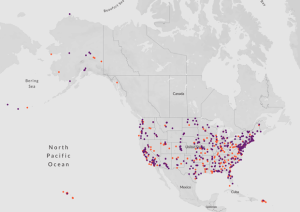Hazardous PFAS Exposure in the Military
Military members and their families are becoming sick after being exposed to the contaminant PFAS on US military bases. PFAS contamination is also threatening water supplies nationwide. The slow cleanup process on multiple military bases is receiving attention in the halls of the US Congress, and there is a push for greater accountability. The PFAS eventually seep into groundwater and poison local water supplies outside military bases. In 2021 the city of Dayton, Ohio, sued the Defense Department for polluting its water. In 2019 New Mexico countersued the US Air Force for contaminating its water supply after trying to make the USAF clean up PFAS contamination.
Polyfluoroalkyl Substances (PFAS)
Polyfluoroalkyl substances ( PFAS ) are a large group of human-made chemical compounds pervasive in manufacturing. PFAS are in home products, food packaging, and even our clothing. Exposure to these compounds links to health concerns, including multiple cancers, immune dysfunction, and decreased fertility. Some of the highest concentrations of PFAS in the US are in or near military bases. Speculation connects to the military’s long-time reliance on the firefighting foam AFFF , laden with PFAS. Although the military is phasing out AFFF use, the accumulated chemicals are difficult to remove from the environment, and the damage to human health is already in play.
The Threat to Military Families
Military members and their families are learning that their exposure to these active chemical compounds is thousands of times more toxic than newly released EPA acceptable exposure limits. Like the burn pits of the US military presence in the Afghan region and defoliant Agent Orange before it in Vietnam, PFAS presents a significant health threat. The US Department of Defense has an investment of over $1.5 billion dedicated to PFAS research and cleanup proposals and actions. Some estimates claim more than 98 percent of all Americans’ blood contains some form of PFAS. There is a lot of uncertainty about fixing the issue, helping those already harmed by exposure, and what branches of government are responsible for funding the cleanup and healthcare for the afflicted.
Clean Up Efforts
The Department of Defense, in conjunction with other federal agencies such as the Department of Veterans Affairs, the EPA, the CDC, and more, are heavily investing time and money to accelerate cleanup and resolve uncertainties. However, Richard G. Kidd, Deputy Assistant Secretary of Defense for Environment and Energy Resilience, states , “Based on what we know today, it will take years to define the scope of our cleanup and decades before its complete.”
Decontaminating sites, creating filtration systems to provide safe water, and providing untainted bottled water for drinking are priorities. Wells will be drilled at strategic locations to identify the nature and extent of the groundwater plume. Then the PFAS-laden water will pump through a removal filter and back into the groundwater. This technique is a pump-and-treat process employed to clean up other chemicals in the groundwater for decades. Although the process is effective, it takes a long time, particularly when standard measures are in parts per trillion. The Department of Defense is investing billions in research and development of new technologies to mitigate this lengthy timeline.
Below is a chart illustrating confirmed (purple) and suspected (orange) military sites that are contaminated according to the non-profit Environmental Working Group ( ewg.org ). Today the number of military sites is nearly 700. Non-military sites account for 2,854 locations in fifty states and two territories as of October 2021.

Because contamination levels on military sites tend to be higher by parts per thousand than on civilian sites, the Department of Defense and Veterans Affairs are hustling to determine their level of responsibility to handle the coming onslaught of military service member and veteran claims.
Legislation Addressing PFAS
In March of 2022, Congressman Dan Kildee (D), a co-chair of the bipartisan Congressional PFAS Task Force, introduced new legislation requiring the VA to cover health conditions that link to PFAS contamination at military bases. The bill includes healthcare services and benefits for service members and their families exposed to PFAS. The Veterans Exposed to Toxic PFAS Act ( VET PFAS Act ) will make the VA responsible for PFAS-affected veterans and their families eligible for disability payments and medical care.
Congressman Kildee’s action is the beginning of accountability and action for those service members and families in contaminated environments. Currently, the VA website only addresses PFAS-contaminated locations and studies identifying problems and potential fixes. While this is a good start, a law that funds the human conditions of illness and disability of service members and families is necessary. Your veterans attorney can update you on PFAS veteran assistance and the needed passing of the VETS PFAS Act. Your lawyer’s veteran expertise will help you get the healthcare and benefits you need as soon as they become available. If you have questions or would like to discuss your legal matters please contact us at 989-495-2555.
The post Hazardous PFAS Exposure in the Military appeared first on Malicoat Law, PLC.

